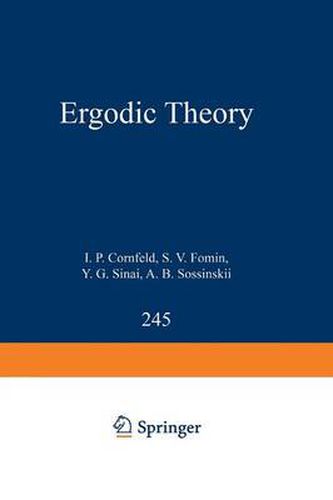Readings Newsletter
Become a Readings Member to make your shopping experience even easier.
Sign in or sign up for free!
You’re not far away from qualifying for FREE standard shipping within Australia
You’ve qualified for FREE standard shipping within Australia
The cart is loading…






This title is printed to order. This book may have been self-published. If so, we cannot guarantee the quality of the content. In the main most books will have gone through the editing process however some may not. We therefore suggest that you be aware of this before ordering this book. If in doubt check either the author or publisher’s details as we are unable to accept any returns unless they are faulty. Please contact us if you have any questions.
Ergodic theory is one of the few branches of mathematics which has changed radically during the last two decades. Before this period, with a small number of exceptions, ergodic theory dealt primarily with averaging problems and general qualitative questions, while now it is a powerful amalgam of methods used for the analysis of statistical properties of dyna mical systems. For this reason, the problems of ergodic theory now interest not only the mathematician, but also the research worker in physics, biology, chemistry, etc. The outline of this book became clear to us nearly ten years ago but, for various reasons, its writing demanded a long period of time. The main principle, which we adhered to from the beginning, was to develop the approaches and methods or ergodic theory in the study of numerous concrete examples. Because of this, Part I of the book contains the description of various classes of dynamical systems, and their elementary analysis on the basis of the fundamental notions of ergodicity, mixing, and spectra of dynamical systems. Here, as in many other cases, the adjective elementary i~ not synonymous with simple.
Part II is devoted to abstract ergodic theory.
It includes the construc tion of direct and skew products of dynamical systems, the Rohlin-Halmos lemma, and the theory of special representations of dynamical systems with continuous time. A considerable part deals with entropy.
$9.00 standard shipping within Australia
FREE standard shipping within Australia for orders over $100.00
Express & International shipping calculated at checkout
Stock availability can be subject to change without notice. We recommend calling the shop or contacting our online team to check availability of low stock items. Please see our Shopping Online page for more details.
This title is printed to order. This book may have been self-published. If so, we cannot guarantee the quality of the content. In the main most books will have gone through the editing process however some may not. We therefore suggest that you be aware of this before ordering this book. If in doubt check either the author or publisher’s details as we are unable to accept any returns unless they are faulty. Please contact us if you have any questions.
Ergodic theory is one of the few branches of mathematics which has changed radically during the last two decades. Before this period, with a small number of exceptions, ergodic theory dealt primarily with averaging problems and general qualitative questions, while now it is a powerful amalgam of methods used for the analysis of statistical properties of dyna mical systems. For this reason, the problems of ergodic theory now interest not only the mathematician, but also the research worker in physics, biology, chemistry, etc. The outline of this book became clear to us nearly ten years ago but, for various reasons, its writing demanded a long period of time. The main principle, which we adhered to from the beginning, was to develop the approaches and methods or ergodic theory in the study of numerous concrete examples. Because of this, Part I of the book contains the description of various classes of dynamical systems, and their elementary analysis on the basis of the fundamental notions of ergodicity, mixing, and spectra of dynamical systems. Here, as in many other cases, the adjective elementary i~ not synonymous with simple.
Part II is devoted to abstract ergodic theory.
It includes the construc tion of direct and skew products of dynamical systems, the Rohlin-Halmos lemma, and the theory of special representations of dynamical systems with continuous time. A considerable part deals with entropy.